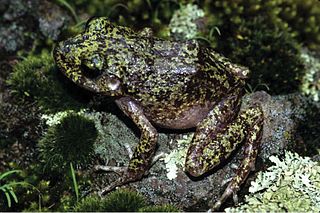
The Sierra de Los Tuxtlas are a volcanic belt and mountain range along the southeastern Veracruz Gulf coast in Eastern Mexico. The Los Tuxtlas Biosphere Reserve includes the coastal and higher elevations of the Sierra de Los Tuxtlas.
Craugastor adamastus is a species of frog in the family Craugastoridae. It is endemic to Guatemala and only known from its type locality near Aldea Vista Hermosa, on the northern slopes of the eastern portion of the Sierra de las Minas, where the type series was collected in 1980–1981.
Craugastor aphanus is a species of frog in the family Craugastoridae. It is endemic to the Sierra del Mico and Sierra de las Minas ranges in the Izabal Department of eastern Guatemala.
Craugastor bocourti is a species of frog in the family Craugastoridae. It is endemic to Guatemala and found on the mountains of the Alta Verapaz Department and the Sierra de las Minas. It is named after Marie Firmin Bocourt, a French zoologist and artist.
Craugastor coffeus is a species of frog in the family Craugastoridae. It is found in Honduras and possibly Guatemala. Its natural habitats are subtropical or tropical moist montane forests and plantations . It is threatened by habitat loss.
Craugastor fecundus is a species of frog in the family Craugastoridae. It is endemic to Honduras. Its natural habitats are subtropical or tropical moist lowland forests, subtropical or tropical moist montane forests, and rivers. It is threatened by habitat loss.

Craugastor longirostris is a species of frog in the family Craugastoridae. It is found in Ecuador from the Guayas Province northwards to western Colombia extreme eastern Panama, with isolated populations in the Magdalena Valley, Colombia. Its natural habitats are lowland and submontane rainforests, occasionally dry forests. It is potentially threatened by habitat loss.
Craugastor megalotympanum is a species of frog in the family Craugastoridae. It is endemic to the Sierra de los Tuxtlas range in southern Veracruz state, Mexico.
Craugastor nefrens is a species of frog in the family Craugastoridae. It is endemic to Guatemala and known from the Sierra de Caral in the Izabal Department; it is expected to occur in adjacent Honduras too. Its natural habitat is moist tropical forest where they are found at night perched on leaves 0.3–2 metres above the ground.
Gunther's robber frog, Günther's robber frog, or Guerreran robber frog is a species of frog in the family Craugastoridae. It is endemic to the Sierra Madre del Sur in the Guerrero state, Mexico. Its natural habitats are pine, oak, and pine-oak forests with plenty of leaf-litter on the ground. It is a relatively common species but declining and threatened by habitat loss and disturbance.
Craugastor omoaensis is a species of frog in the family Craugastoridae. It is endemic to Honduras and also is one of 13 species of amphibians and reptiles that are endemic to the Sierra de Omoa. It is known from only 24 specimens studied. Its natural habitats are subtropical or tropical moist montane forests, rivers, and intermittent rivers.
Craugastor saltuarius is a species of frog in the family Craugastoridae. It is endemic to Honduras. Its natural habitat is subtropical or tropical moist montane forests. It is threatened by habitat loss.
Craugastor sartori, also known as the Chiapas dwarf robber frog, is a species of frog in the family Craugastoridae. It is endemic to Mexico and known from the Sierra Madre de Chiapas in the vicinity of Cerro Ovando, at elevations of about 1,200–1,900 m (3,900–6,200 ft) asl. Its natural habitats are montane cloud and mixed forests. It is threatened by habitat loss caused by particularly logging.
Craugastor spatulatus is a species of frog in the family Craugastoridae. It is endemic to Mexico and known from Cuautlapam in central Veracruz and Vista Hermosa in the Sierra Juárez, Oaxaca. Its natural habitat is cloud forest. This formerly abundant species has strongly declined because of habitat loss, although other factors may have been involved too.

Craugastor tarahumaraensis is a species of frog in the family Craugastoridae. It is endemic to Mexico and known from the Sierra Madre Occidental between the eastern Sonora and western Chihuahua in the north and Jalisco in the south. Its common name is Tarahumara barking frog. The type locality is Mojárachic, in the Tarahumara Mountains, Chihuahua.
Craugastor trachydermus is a species of frog in the family Craugastoridae. It is endemic to Guatemala and only known from its type locality, Xiacam in the Sierra de Santa Cruz, Izabal Department, where the type series was collected in 1989. The species might already be extinct. However, specimens collected some 10 km from the type locality might belong to this species.
Craugastor xucanebi is a species of frog in the family Craugastoridae. It is endemic to Guatemala.
Craugastor olanchano is a species of frog in the family Craugastoridae. It is endemic to Honduras. Its natural habitats are subtropical or tropical moist montane forests and rivers.
Craugastor vulcani is a species of frog in the family Craugastoridae. It is endemic to the Sierra de los Tuxtlas range in southern Veracruz state, Mexico. Its name refers to its type locality on the San Martin Tuxtla volcano. Its natural habitats are premontane and lower montane wet forests where it occurs along streams. The species is likely impacted by habitat loss, and its distribution area is small, prompting classification as an endangered species.
The Sierra de Santa Cruz is a small mountain range in eastern Guatemala. It is situated north of Lake Izabal, in the department of Izabal. The mountain range has a south-west to north-east orientation, and is approximately 55 km long and 13 km wide. Its highest peaks have an altitude of approximately 1100 m.




